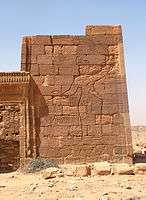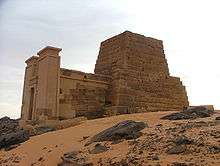Amanitore
Amanitore (c. 50 CE) was a Nubian Kandake, or queen regnant, of the ancient Kushitic Kingdom of Meroë, which also is referred to as Nubia in many ancient sources. Alternative spellings include Candace and Kentake. In Egyptian hieroglyphics the throne name of Amanitore reads as Merkare. Many Kandakes are described as warrior-queens who led forces in battle.
| Amanitore | |
|---|---|
| Queen of Kush | |
 Amanitore at Wad ban Naqa | |
| Reign | 1 BCE – 20 CE |
| Predecessor | Teriteqas (50 BCE–1 BCE)[1] |
| Successor | Kandake Amanitaraqide[1] |
| Born | BCE |
| Died | 20 CE |
| Burial | Pyramid at Meroë |
| Egyptian | Merkare |
| Dynasty | Meroitic |
Kandake Amanitore is often mentioned as co-regent with Natakamani although it is unclear whether she was his wife or mother.[2]
Her royal palace was at Gebel Barkal in modern-day Sudan, which now is a UNESCO heritage site. The area of her rule was between the Nile and the Atbara rivers.[3]
She was part of the Meroitic historical period and her reign began in 1 BCE. The rule of her successor, Amanitaraqide, was complete by 50 CE.[1]
Amanitore is mentioned in a number of texts as a ruler. These include the temple at the Nubian capital of Napata in present-day Sudan, in a temple in Meroë near Shendi, again in Sudan, and at the Naqa Lion Temple. Images of Natakamani frequently include an image of Amanitore; however, it could be that Amanitore was his mother rather than his wife. A Kandake was a powerful position in the hierarchy of Kush. The mothers would rule and create their sons as rulers, but they also deposed their own sons too. In fact, a Kandake could order the king to commit suicide to end his rule, an order that he was required to follow.
Amanitore is buried in her own pyramid in Meroë. The tomb is approximately six metres square at its base, and not a pyramid in the mathematical sense.
Some sources say otherwise, but she is said to be mentioned in the Bible in the story about the conversion of the Ethiopian in Acts 8:26–40:[4]
And the angel of the Lord spoke to Philip, saying, Get up, and go toward the south unto the way that goes down from Jerusalem to Gaza, which is desert. And he got up and went: and, behold, a man of Ethiopia, a eunuch of great authority under Candace queen of the Ethiopians, who had the charge of all her treasure, and had come to Jerusalem to worship, was returning, and sitting in his chariot read Isaiah the prophet…. [5]
Amanitore was among the last great Kush builders. She was involved in restoring the large temple for Amun at Meroë and the Amun temple at Napata after it was demolished by the Romans. Reservoirs for the retention of water also were constructed at Meroë during her reign.[3] The two rulers also built Amun temples at Naqa and Amara.
The quantity of building that was completed during the middle part of the first century indicates that this was the most prosperous time in Meroitic history.[6] More than two hundred Nubian pyramids were built, most plundered in ancient times.
Her country was immediately south of what was ancient Egypt and shared its language in surviving texts. Other aspects of the culture differ significantly, but are not well known and others seem to have influenced the Ancient Egyptian culture—including religious influences. It was a wealthy country, having large resources of gold, and exported jewelry, exotic animals, and textiles.
 Queen Amanitore quashing her enemies
Queen Amanitore quashing her enemies Pyramid of Amanitore in Meroë
Pyramid of Amanitore in Meroë- Pyramids built in Meroë differed significantly from those of the Ancient Egyptians
In popular culture
- Amanitore leads the Nubian civilization in the 2016 4X video game Civilization VI developed by Firaxis Games.[7]
References
- Department of Egyptian Art. "List of Rulers: Ancient Sudan". In Heilbrunn Timeline of Art History. New York: The Metropolitan Museum of Art, 2000–. metmuseum.org (October 2001)
- Török, László p.262 The Image of the Ordered World in Ancient Nubian Art: The Construction of the Kushite Mind (800 BCE – 300 CE) (Probleme Der Agyptologie) Brill; illustrated edition (28 Nov 2001) ISBN 978-90-04-12306-9
- 50 Greatest Africans — Pharaoh Natakamani and Queen Amanitore & Ngola Ann Nzinga, whenweruled.com, accessed 28 December 2008
- "Women in Power". Archived from the original on 2008-12-04. Retrieved 2008-12-28.
- Acts 8:26-27
- The Kingdom of Kush, László Török, 198 and p461, ISBN 90-04-10448-8, accessed 27 December 2008
- "Civilization VI: Kandake Amanitore Rules Nubia". Official Civilization Website. July 27, 2017. Retrieved July 27, 2017.
External links
| Wikimedia Commons has media related to Amanitore. |